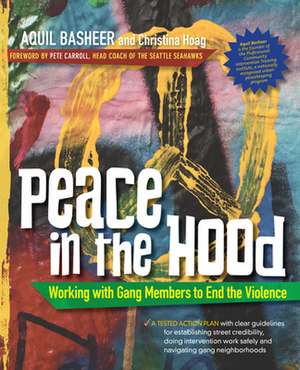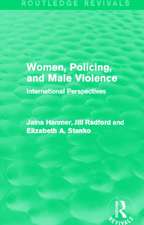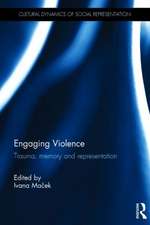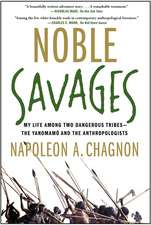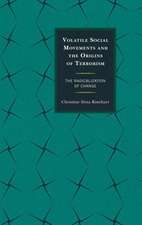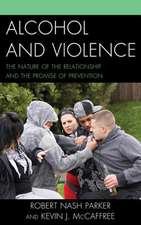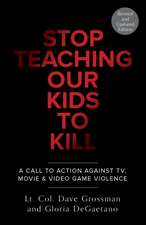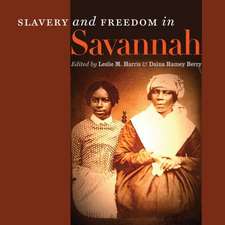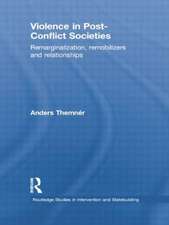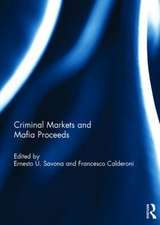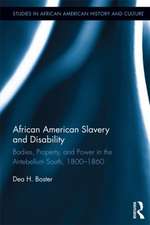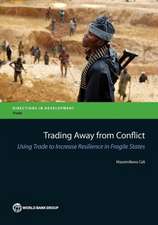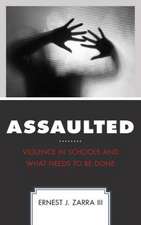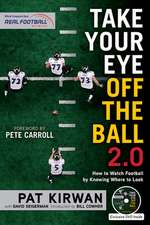Peace in the Hood: Working with Gang Members to End the Violence
Autor Aquil Basheer, Christina Hoag Pete Carrollen Limba Engleză Paperback – 7 iul 2014
Peace In the Hood evokes the reality of gangland warfare but also acknowledges the possibility of peace. Written by Basheer, a pioneer of the interventionist movement, it documents the lessons he learned from over 40 years of working in inner cities.
This book is designed to teach anyone how to be an interventionist, offering clear guidelines on the necessities of intervention work, including understanding the gang mindset, learning how to evaluate rumors for truth, and convincing young people to leave gangs. Each chapter deals with one key aspect of peacemaking, and the advice comes with anecdotes from Basheer’s own life.
Peace In the Hood includes real-life accounts of Basheer’s interactions with gang members offering unique insight into gang culture. Its descriptions of the fairly new field of peacekeeping and intervention with its mix of story and advice make it both a perfect tool for students and teachers who study social justice and anyone simply looking for a fascinating read. Being the first book to offer a detailed description of the process of making peace within gangs, it’s a must-read for anyone seeking a deeper understanding of gangs and the efforts to make peace within them.
This book is designed to teach anyone how to be an interventionist, offering clear guidelines on the necessities of intervention work, including understanding the gang mindset, learning how to evaluate rumors for truth, and convincing young people to leave gangs. Each chapter deals with one key aspect of peacemaking, and the advice comes with anecdotes from Basheer’s own life.
Peace In the Hood includes real-life accounts of Basheer’s interactions with gang members offering unique insight into gang culture. Its descriptions of the fairly new field of peacekeeping and intervention with its mix of story and advice make it both a perfect tool for students and teachers who study social justice and anyone simply looking for a fascinating read. Being the first book to offer a detailed description of the process of making peace within gangs, it’s a must-read for anyone seeking a deeper understanding of gangs and the efforts to make peace within them.
Preț: 131.34 lei
Nou
Puncte Express: 197
Preț estimativ în valută:
25.14€ • 26.04$ • 20.98£
25.14€ • 26.04$ • 20.98£
Carte disponibilă
Livrare economică 01-15 martie
Preluare comenzi: 021 569.72.76
Specificații
ISBN-13: 9780897937047
ISBN-10: 089793704X
Pagini: 240
Ilustrații: B&W photos
Dimensiuni: 188 x 231 x 15 mm
Greutate: 0.39 kg
Editura: Hunter House Publishers
ISBN-10: 089793704X
Pagini: 240
Ilustrații: B&W photos
Dimensiuni: 188 x 231 x 15 mm
Greutate: 0.39 kg
Editura: Hunter House Publishers
Cuprins
Foreword: NFL Seattle Seahawks Coach Pete Carroll
Introduction: One Bullet at a Time
1. License to Operate
2. The Mindset
3. The Yellow Tape
4. The Grapevine
5. The White Flag
6. The Victims
7. Street Survival
8. The Parley
9. The Debrief
10. Colors on Campus
11. Second Chance
12. Baby Mama, Baby Daddy
13. Community Repair
14. Staying True to the Mission
15. The Business
Acknowledgements
Introduction: One Bullet at a Time
1. License to Operate
2. The Mindset
3. The Yellow Tape
4. The Grapevine
5. The White Flag
6. The Victims
7. Street Survival
8. The Parley
9. The Debrief
10. Colors on Campus
11. Second Chance
12. Baby Mama, Baby Daddy
13. Community Repair
14. Staying True to the Mission
15. The Business
Acknowledgements
Recenzii
Praise for Aquil Basheer's Professional Community Intervention Training Institute (PCITI):
“I am so humbled to be a part of this work and will always support it. To see the effectiveness of Aquil Basheer and his expertise plus to know how many lives it has altered and saved is outstanding.”
— Pete Carroll, Coach of the Seattle Seahawks, founder of A Better LA, A Better Seattle
“This program is way ahead of its time. It is the first of its kind in the nation and has been a tremendous asset to the communities of Los Angeles which it serves.” — Congressman Tony Cardenas
“This is excellent training, it could not be better. This is what everyone—cops, emergency and first responders, social service workers, and doctors—needs to know before they go into the streets. I believe this work should be taken to scale throughout the country.”
— Lee Baca, Sheriff of Los Angeles County
“Professional Community Intervention Training Institute demonstrated a profound impact on the lives of its participants . . . [T]his program is quite simply a treasure and plays an important role in revitalizing and empowering communities throughout Los Angeles.”
— Jorja Leap, UCLA professor of public welfare, and gang consultant to the Los Angeles County Sheriff’s Department and the City of Los Angeles
“I am so humbled to be a part of this work and will always support it. To see the effectiveness of Aquil Basheer and his expertise plus to know how many lives it has altered and saved is outstanding.”
— Pete Carroll, Coach of the Seattle Seahawks, founder of A Better LA, A Better Seattle
“This program is way ahead of its time. It is the first of its kind in the nation and has been a tremendous asset to the communities of Los Angeles which it serves.” — Congressman Tony Cardenas
“This is excellent training, it could not be better. This is what everyone—cops, emergency and first responders, social service workers, and doctors—needs to know before they go into the streets. I believe this work should be taken to scale throughout the country.”
— Lee Baca, Sheriff of Los Angeles County
“Professional Community Intervention Training Institute demonstrated a profound impact on the lives of its participants . . . [T]his program is quite simply a treasure and plays an important role in revitalizing and empowering communities throughout Los Angeles.”
— Jorja Leap, UCLA professor of public welfare, and gang consultant to the Los Angeles County Sheriff’s Department and the City of Los Angeles
Notă biografică
Aquil Basheer is a foremost expert and pioneer in the field of street violence intervention. He founded and operates the Professional Community Intervention Training Institute (PCITI), the nation's only 18-week gang interventionist training and personal development academy. He has also served as as an anti-violence consultant in Latin America, Asia, and Africa. The subject of articles in the Los Angeles Times and other major media, Basheer lives in Moreno Valley, CA. Christina Hoag is a journalist who has reported on social and political issues in the United States, Latin America, and the Caribbean for Time, BusinessWeek, The New York Times, and more. Most recently an urban affairs reporter for The Associated Press in Los Angeles, Hoag lives in Santa Monica, CA. Pete Carroll is the coach for the Seattle Seahawks and lives in Seattle.
Extras
From the Introduction: ONE BULLET AT A TIME
This is the unseen work of hard-core street intervention — it takes a lot of guts, but rarely, if ever, results in any glory. Results are often measured in what didn’t happen, not what did. That’s the goal of violence intervention — to stop the bloodshed on our streets in a way that law enforcement and others can’t. We stop it from the inside, not the outside.
Intervention and prevention are major tools of the fight against violence. They don’t replace some of the traditional measures: social services, schools, parenting, law enforcement and personal development, which are all essential pieces of the equation. Instead, intervention and prevention work alongside those elements and bring expertise and authority that other agencies lack — we have been there, we have lived the violence. In my view, we need all the tools and skills we can lay our hands on if we are to combat the epidemic of violence in our society.
My mission is a holistic one — to repair broken communities, stop bloodshed and attempt to provide hope to many individuals who have lost faith. I am a community interventionist, but much of what I do relates to gangs, because they are a big part of the reason why our communities need repair. A choke hold of crime and violence petrifies a community, locks it into despair and fear, robbing it of progress and hope.
Gangs are a travesty no one has been able to solve or even make a dent in. Instead, the opposite has happened. They have spread across the United States and the world. In Los Angeles and other big cities such as New York and Chicago, gangs have been deeply entrenched for decades. In Los Angeles County, the nation’s gang capital, gang population estimates range from 700 to 1,100 street gangs with 50,000 to more than 100,000 members. No one really has an accurate headcount. What police do know is that eighty percent of crime in Los Angeles, ranging from home invasions to homicide, is rooted in gang-related causes.
Police have also come to realize they cannot do it alone. As Los Angeles Police Chief Charlie Beck often says, “we cannot arrest our way out of this.” Law enforcement has seen time and again that as soon as one set is taken down, more shotcallers and soldiers pop up to take the place of those behind bars. Poverty, lack of jobs, and low quality schools create a never-ending supply of candidates who don’t see opportunity anywhere else.
Once gangs take hold in a neighborhood, the community changes dramatically. Young men are challenged if they walk down an unfamiliar block, fifth-graders are recruited to sell drugs on their way to school, parks become gang hangouts instead of children’s play areas, businesses are forced to pay protection money, people have to be careful about what color clothing they wear in a particular neighborhood — the wrong color shirt or cap in the wrong place can bring a hail of gunfire.
This is no longer just a big-city phenomenon. Gangs are extending their influence as they seek new markets for their drug trade and other criminal businesses, including human trafficking, prostitution and robberies. In the last couple years, I’ve been called to train interventionists and set up intervention programs in Little Rock, Arkansas; Atlanta, Georgia; Corpus Christi, Texas; Seattle and Tacoma, Washington; and Omaha, Nebraska. We have also worked in cities with longstanding gang problems: New York, Chicago, Oakland, California, and Washington D.C.
The reach of my team has also extended internationally. We have also been called in to do trainings and help develop the public safety infrastructure in Ghana, Togo, Egypt, Argentina, Brazil, Venezuela, Peru, Chile, Bolivia, and Uruguay, El Salvador, and China.
With adjustments to the needs of each community, intervention can be adapted to rural areas, small and large cities, to any culture because the premise is simple: Violence and those who practice it have common denominators so we have developed operational procedures and responses to deal with it. We come from the communities where hostility and violence are part of everyday life so we know what it’s like to live with it. We don’t judge people because we’ve been there. People can talk to us because they know our role is not to arrest them or turn them in, take their children away, kick them out of school. We don’t carry weapons. The only authority we have comes from the community itself — our street credibility, what we call an “LTO,” a license to operate. The LTO is the basis of how we work.
The majority of interventionists are former gang members and community activists — I happen to be a former militant from the Black Power movement seasoned in the 1960s' revolutionary era and a veteran community activist. Much of what we do is gang intervention, simply because the sets cause a large amount of the violence and chaos in inner-cities. But we also deal with situations involving domestic violence, child abuse, youth aggression, community mobilization, police brutality, and public safety in crime-ridden communities where standard solutions have not worked. We work with both the victims and the perpetrators. We do a lot of preventive work — with youth in schools, inmates in prisons, parolees returning home — so violence is not an option they turn to.
Hard-core intervention work is not for everyone. Stepping into the unforgiving world of violence and mayhem is stressful, challenging and takes a toll on you and your family. It involves a delicate balancing act. Interventionists cannot get involved in the vices of gang life, but we have to remain close enough to the gang to maintain ties and influence, and gather the street intelligence we need to operate. We must work to steer youth away from gangs, but cannot judge gang lifestyle. We are not police informants, but must maintain a loose working relationship with law enforcement and all other official agencies.
The work can also be physically dangerous, mentally taxing and downright disheartening at times. We are dealing with people who see violence as a source of their self-esteem, a badge of honor and a normal way of doing business. For some, it’s a family tradition going back as many as three generations. In a shoot-first-questions-later climate, a wrong word, look or gesture, or even just the perception of such, can result in gunfire at any moment. Getting in the middle of this mindset requires highly developed interpersonal skills, cool, rational thinking, and a lot of commitment. I emphasize the latter. Many interventionists start with good intentions but a large percentage fall by the wayside, unable to cope with the emotional challenges, the lack of resources, the low level of appreciation for the work we do and a few are unable to resist re-entering gang life. The reward in the work may come just in the form of a teary-eyed hug from a mother, father, sister or brother at one o’clock in the morning, but it largely comes from within — knowing you helped prolong lives.
That’s why I have written this book. Coming from this culture and putting in over four decades of experience on streets all over this country and others, I have learned what to do and what not to do. I now train former gang members and many other professionals to be certified interventionists. I turn our participants into professional peacekeepers in a 20-week course, including a four-week internship on the streets practicing what they learned in the classroom.
The Professional Community Intervention Training Institute (PCITI) has now become a national model for gang intervention/violence abatement practitioner-based training and education. Our standards and professional certification have been adopted by municipalities nationwide.
From Chapter 1: LICENSE TO OPERATE (LTO)
How do you get it?
The big question I always get about LTO is “how do you get it?” Many interventionists are former gang members so they start out with a certain amount of LTO with their own sets and hood for doing set work. That has to be earned, too. In the upside-down gang culture, respect is often gained by doing the worst, most undesirable things. That means carrying out the dirty work of the set. Doing prison time, and more importantly how you do the time — holding your own, keeping up your rep and respect at all costs, is another way gang members earn respect of peers. Not snitching to law enforcement to save yourself is another way. It’s not just one thing. It’s a continual display of loyalty to the gang that earns high ranked LTO.
I get a lot of calls from all kinds of people who are not established gang members and want or need access to gangs or the neighborhoods they operate in. School principals need to ensure kids can walk to school safely, social workers need to ensure kids are not being abused, recreation and parks workers need to clean up the parks that gangs control, maintenance crews need to whitewash gang graffiti tags, cops need to tamp down rumors to head off retaliatory violence. Businesses need to be able to operate in gang turf. Sociologists and psychologists want to study them. Journalists want to write about them.
Gang members don’t respond well to outsiders. They are suspicious and distrustful, sometimes because of the criminal nature of their activities, sometimes because they know the outsiders want something from the culture, and because they come from an environment where official people mean trouble. But the main factor is that they regard their community as theirs and they are the gatekeepers.
Neighborhood “ownership” is not a concept that people from middle-class communities can easily get their heads around. It just doesn’t happen in suburban housing developments with manicured lawns and tricycles in the driveways. But in gang zones, it’s so serious that people lose their lives over it. Turf control is a critical part of gang culture. The worst thing you can do is ignore the gang or dismiss it. Gang members will make it impossible for you to operate in that community. The bottom line is you need to establish a credible LTO to move in these neighborhoods. There are a couple ways to get that.
Gangs exist in neighborhoods with a lot of needs. The first step is to find out what the local people need and offer something toward that. If you are there only to take, you will not get cooperation from the shotcallers, or anyone else — and that can mean heavy-duty harassment.
Magic Johnson announced a big plan to build a multimillion-dollar multiplex movie theatre in the Crenshaw area of South L.A. It was a big deal back in 1994 — it was all over the news and won a lot of praise from city leaders as a sign of urban revitalization. The local community was pleased, too — it was going to bring jobs to a community that badly needed them.
The company broke ground on construction, but the expected jobs didn’t materialize. The brothers watched angrily as union construction workers paraded in to the site every morning — all outsiders. They felt that all Magic’s rhetoric about investing in urban communities was just that — rhetoric. They were being ignored.
They made their feelings known in a silent, but not-so-subtle way. Every morning a couple dozen brothers would go down to the construction site and surround it, striking the gang stance — arms crossed, legs apart and eyes trained unblinkingly on the workers. They said nothing, did nothing, just glared — the classic gang tactic of mad-dogging designed to intimidate. It worked — they unsettled the workers and the foreman contacted the management.
I got called by a close friend of mine and fellow peacekeeper, T Rogers, who was an interventionist and former Blood from the neighborhood, known as the Jungle, T’s home turf. He had been handling the issue well, but he needed some serious backup to deal with Magic’s lead team...
This is the unseen work of hard-core street intervention — it takes a lot of guts, but rarely, if ever, results in any glory. Results are often measured in what didn’t happen, not what did. That’s the goal of violence intervention — to stop the bloodshed on our streets in a way that law enforcement and others can’t. We stop it from the inside, not the outside.
Intervention and prevention are major tools of the fight against violence. They don’t replace some of the traditional measures: social services, schools, parenting, law enforcement and personal development, which are all essential pieces of the equation. Instead, intervention and prevention work alongside those elements and bring expertise and authority that other agencies lack — we have been there, we have lived the violence. In my view, we need all the tools and skills we can lay our hands on if we are to combat the epidemic of violence in our society.
My mission is a holistic one — to repair broken communities, stop bloodshed and attempt to provide hope to many individuals who have lost faith. I am a community interventionist, but much of what I do relates to gangs, because they are a big part of the reason why our communities need repair. A choke hold of crime and violence petrifies a community, locks it into despair and fear, robbing it of progress and hope.
Gangs are a travesty no one has been able to solve or even make a dent in. Instead, the opposite has happened. They have spread across the United States and the world. In Los Angeles and other big cities such as New York and Chicago, gangs have been deeply entrenched for decades. In Los Angeles County, the nation’s gang capital, gang population estimates range from 700 to 1,100 street gangs with 50,000 to more than 100,000 members. No one really has an accurate headcount. What police do know is that eighty percent of crime in Los Angeles, ranging from home invasions to homicide, is rooted in gang-related causes.
Police have also come to realize they cannot do it alone. As Los Angeles Police Chief Charlie Beck often says, “we cannot arrest our way out of this.” Law enforcement has seen time and again that as soon as one set is taken down, more shotcallers and soldiers pop up to take the place of those behind bars. Poverty, lack of jobs, and low quality schools create a never-ending supply of candidates who don’t see opportunity anywhere else.
Once gangs take hold in a neighborhood, the community changes dramatically. Young men are challenged if they walk down an unfamiliar block, fifth-graders are recruited to sell drugs on their way to school, parks become gang hangouts instead of children’s play areas, businesses are forced to pay protection money, people have to be careful about what color clothing they wear in a particular neighborhood — the wrong color shirt or cap in the wrong place can bring a hail of gunfire.
This is no longer just a big-city phenomenon. Gangs are extending their influence as they seek new markets for their drug trade and other criminal businesses, including human trafficking, prostitution and robberies. In the last couple years, I’ve been called to train interventionists and set up intervention programs in Little Rock, Arkansas; Atlanta, Georgia; Corpus Christi, Texas; Seattle and Tacoma, Washington; and Omaha, Nebraska. We have also worked in cities with longstanding gang problems: New York, Chicago, Oakland, California, and Washington D.C.
The reach of my team has also extended internationally. We have also been called in to do trainings and help develop the public safety infrastructure in Ghana, Togo, Egypt, Argentina, Brazil, Venezuela, Peru, Chile, Bolivia, and Uruguay, El Salvador, and China.
With adjustments to the needs of each community, intervention can be adapted to rural areas, small and large cities, to any culture because the premise is simple: Violence and those who practice it have common denominators so we have developed operational procedures and responses to deal with it. We come from the communities where hostility and violence are part of everyday life so we know what it’s like to live with it. We don’t judge people because we’ve been there. People can talk to us because they know our role is not to arrest them or turn them in, take their children away, kick them out of school. We don’t carry weapons. The only authority we have comes from the community itself — our street credibility, what we call an “LTO,” a license to operate. The LTO is the basis of how we work.
The majority of interventionists are former gang members and community activists — I happen to be a former militant from the Black Power movement seasoned in the 1960s' revolutionary era and a veteran community activist. Much of what we do is gang intervention, simply because the sets cause a large amount of the violence and chaos in inner-cities. But we also deal with situations involving domestic violence, child abuse, youth aggression, community mobilization, police brutality, and public safety in crime-ridden communities where standard solutions have not worked. We work with both the victims and the perpetrators. We do a lot of preventive work — with youth in schools, inmates in prisons, parolees returning home — so violence is not an option they turn to.
Hard-core intervention work is not for everyone. Stepping into the unforgiving world of violence and mayhem is stressful, challenging and takes a toll on you and your family. It involves a delicate balancing act. Interventionists cannot get involved in the vices of gang life, but we have to remain close enough to the gang to maintain ties and influence, and gather the street intelligence we need to operate. We must work to steer youth away from gangs, but cannot judge gang lifestyle. We are not police informants, but must maintain a loose working relationship with law enforcement and all other official agencies.
The work can also be physically dangerous, mentally taxing and downright disheartening at times. We are dealing with people who see violence as a source of their self-esteem, a badge of honor and a normal way of doing business. For some, it’s a family tradition going back as many as three generations. In a shoot-first-questions-later climate, a wrong word, look or gesture, or even just the perception of such, can result in gunfire at any moment. Getting in the middle of this mindset requires highly developed interpersonal skills, cool, rational thinking, and a lot of commitment. I emphasize the latter. Many interventionists start with good intentions but a large percentage fall by the wayside, unable to cope with the emotional challenges, the lack of resources, the low level of appreciation for the work we do and a few are unable to resist re-entering gang life. The reward in the work may come just in the form of a teary-eyed hug from a mother, father, sister or brother at one o’clock in the morning, but it largely comes from within — knowing you helped prolong lives.
That’s why I have written this book. Coming from this culture and putting in over four decades of experience on streets all over this country and others, I have learned what to do and what not to do. I now train former gang members and many other professionals to be certified interventionists. I turn our participants into professional peacekeepers in a 20-week course, including a four-week internship on the streets practicing what they learned in the classroom.
The Professional Community Intervention Training Institute (PCITI) has now become a national model for gang intervention/violence abatement practitioner-based training and education. Our standards and professional certification have been adopted by municipalities nationwide.
From Chapter 1: LICENSE TO OPERATE (LTO)
How do you get it?
The big question I always get about LTO is “how do you get it?” Many interventionists are former gang members so they start out with a certain amount of LTO with their own sets and hood for doing set work. That has to be earned, too. In the upside-down gang culture, respect is often gained by doing the worst, most undesirable things. That means carrying out the dirty work of the set. Doing prison time, and more importantly how you do the time — holding your own, keeping up your rep and respect at all costs, is another way gang members earn respect of peers. Not snitching to law enforcement to save yourself is another way. It’s not just one thing. It’s a continual display of loyalty to the gang that earns high ranked LTO.
I get a lot of calls from all kinds of people who are not established gang members and want or need access to gangs or the neighborhoods they operate in. School principals need to ensure kids can walk to school safely, social workers need to ensure kids are not being abused, recreation and parks workers need to clean up the parks that gangs control, maintenance crews need to whitewash gang graffiti tags, cops need to tamp down rumors to head off retaliatory violence. Businesses need to be able to operate in gang turf. Sociologists and psychologists want to study them. Journalists want to write about them.
Gang members don’t respond well to outsiders. They are suspicious and distrustful, sometimes because of the criminal nature of their activities, sometimes because they know the outsiders want something from the culture, and because they come from an environment where official people mean trouble. But the main factor is that they regard their community as theirs and they are the gatekeepers.
Neighborhood “ownership” is not a concept that people from middle-class communities can easily get their heads around. It just doesn’t happen in suburban housing developments with manicured lawns and tricycles in the driveways. But in gang zones, it’s so serious that people lose their lives over it. Turf control is a critical part of gang culture. The worst thing you can do is ignore the gang or dismiss it. Gang members will make it impossible for you to operate in that community. The bottom line is you need to establish a credible LTO to move in these neighborhoods. There are a couple ways to get that.
Gangs exist in neighborhoods with a lot of needs. The first step is to find out what the local people need and offer something toward that. If you are there only to take, you will not get cooperation from the shotcallers, or anyone else — and that can mean heavy-duty harassment.
Magic Johnson announced a big plan to build a multimillion-dollar multiplex movie theatre in the Crenshaw area of South L.A. It was a big deal back in 1994 — it was all over the news and won a lot of praise from city leaders as a sign of urban revitalization. The local community was pleased, too — it was going to bring jobs to a community that badly needed them.
The company broke ground on construction, but the expected jobs didn’t materialize. The brothers watched angrily as union construction workers paraded in to the site every morning — all outsiders. They felt that all Magic’s rhetoric about investing in urban communities was just that — rhetoric. They were being ignored.
They made their feelings known in a silent, but not-so-subtle way. Every morning a couple dozen brothers would go down to the construction site and surround it, striking the gang stance — arms crossed, legs apart and eyes trained unblinkingly on the workers. They said nothing, did nothing, just glared — the classic gang tactic of mad-dogging designed to intimidate. It worked — they unsettled the workers and the foreman contacted the management.
I got called by a close friend of mine and fellow peacekeeper, T Rogers, who was an interventionist and former Blood from the neighborhood, known as the Jungle, T’s home turf. He had been handling the issue well, but he needed some serious backup to deal with Magic’s lead team...
